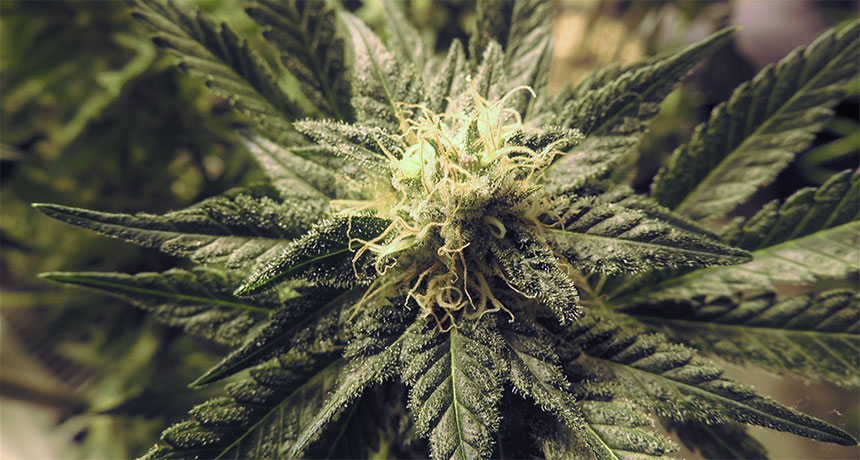Promise and perils of marijuana deserve more scientific scrutiny
Limits on ability to study drug hamper efforts to weigh public health benefits, concerns

HIGH HOPES Cannabis plants such as this one yield marijuana and other substances that deserve expanded study for possible medical benefits, a large research review recommends. But negative physical and psychological effects of cannabis products can’t be ignored, the report says.
tdfugere/pixabay
Marijuana’s medical promise deserves closer, better-funded scientific scrutiny, a new state-of-the-science report concludes.
The report, released January 12 by the National Academies of Sciences, Engineering and Medicine in Washington, D.C., calls for expanding research on potential medical applications of cannabis and its products, including marijuana and chemical components called cannabinoids.
Big gaps in knowledge remain about health effects of cannabis use, for good or ill. Efforts to study these effects are hampered by federal classification of cannabis as a Schedule 1 drug, meaning it has no accepted medical use and a high potential for abuse. Schedule 1 status makes it difficult for researchers to access cannabis. The new report recommends reclassifying the substance to make it easier to study.
Recommendations from the 16-member committee that authored the report come at a time of heightened acceptance of marijuana and related substances. Cannabis is a legal medical treatment in 28 states and the District of Columbia. Recreational pot use is legal in eight of those states and the District.
“The legalization and commercialization of cannabis has allowed marketing to get ahead of science,” says Raul Gonzalez, a psychologist at Florida International University in Miami who reviewed the report before publication. While the report highlights possible medical benefits, Gonzalez notes that it also underscores negative consequences of regular cannabis use. These include certain respiratory and psychological problems.
A 2015 survey indicated that around 22 million people in the United States ages 12 and older ingested some form of cannabis in the last month, mainly as a recreational drug. Roughly 10 percent of those people reported using cannabis solely for medical reasons and 36 percent reported a mix of recreational and medical use.
“This growing acceptance, accessibility and use of cannabis and its derivatives have raised important public health concerns,” says committee chair Marie McCormick, a Harvard T.H. Chan School of Public Health pediatrician.
She and her committee colleagues considered more than 10,700 abstracts of studies on cannabis’s health effects published between January 1, 1999, and August 1, 2016. The committee gave special weight to research reviews published since 2011.
Cannabis and cannabinoids show medical potential, the report concludes. Evidence indicates that these substances substantially reduce chronic pain in adults. Cannabis derivatives ingested in pills by multiple sclerosis patients temporarily reduce self-reported muscle spasms (SN: 6/19/10, p. 16). Cannabinoids also help to prevent and lessen chemotherapy-induced nausea and vomiting in adults.
Less conclusive evidence suggests cannabis and cannabinoids improve sleep for adults with sleep apnea, fibromyalgia, chronic pain and multiple sclerosis, the report says.
“If cannabis was to be classified as a medicine, then it needs to be rigorously tested like all other medicines,” says pharmacologist Karen Wright of Lancaster University in England. She hopes the new report spurs researchers to develop standards for the chemical composition of cannabis products tested as possible medical treatments. Despite cannabis’s medical promise, scientists have more questions than answers about how its use influences physical and mental health.
Encouragingly, studies reviewed by the committee suggest that smoking marijuana, unlike smoking cigarettes, does not increase the chances of developing lung, head and neck cancers. But pot’s relationship to other cancers — as well as to heart attacks, strokes and diabetes — is unclear. And few or no findings support the use of cannabis to treat Tourette’s syndrome, post-traumatic stress disorder, cancer, epilepsy (SN Online: 4/13/15) or other medical ailments.
Evidence does not conclusively link marijuana smoking to respiratory diseases such as asthma. But regular pot use tends to accompany increased chronic bronchitis episodes and an intensified cough and phlegm production, at least until smoking stops.
Cannabis smoke may deter infection-related inflammation in the body. But data are sparse on whether cannabis or its derivatives influence immune responses in healthy people or those with HIV.
There are some clear downsides to consuming marijuana and related substances, the new report adds. Solid scientific support exists for a link between cannabis use and later development of psychotic disorders such as schizophrenia. A moderate relationship exists between cannabis use and the development of addictions to alcohol, tobacco and illegal drugs.
Fairly strong evidence points to learning, memory and attention problems immediately after smoking marijuana. Limited data, however, tie pot use to academic problems, dropping out of school, unemployment or lowered income in adulthood.







